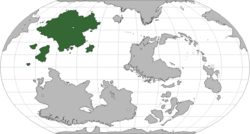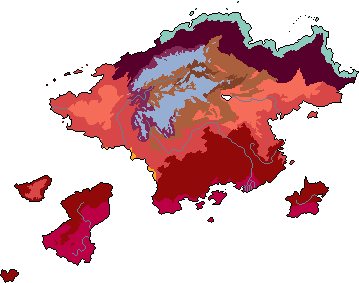Omoserica
Jump to navigation
Jump to search
 | |
| Area | --- |
|---|---|
Omoserica, commonly referred to as China, is a continent in the northern hemisphere. The second largest continent in the world after Originalia, Omoserica boasts the highest mountain range in the world, along with a vast expanse of woodlands to the south. Humanity arrived on Omoserica's southern shores roughly 30,000 years ago, in a slow migration over the ocean from Originalia.
Geography[edit | edit source]
Climate[edit | edit source]
Geology[edit | edit source]
Biodiversity[edit | edit source]
Southern Omoserica[edit | edit source]
Domestic Animals
- Silkworms
- Stag-Moose [1]
- Water buffaloes
Cultivable Flora
- Sorghum
- Yams
- Rice
- Soy
- Cassava
- Bananas
- Sugar cane
- Maize
- Flax
- Tea
- Bamboo
- Taro
- Eddoes
Aquatic Animals
- Bull Shark
Other Animals
- Elephant birds [2]
- Falanouc
- Fossas
- Giant fossas
- Malagasy civets
Other Flora
- Palm Trees
- Tree Heath
- Ginkgoes
- ↑ http://alternatehistory.com/discussion/showpost.php?p=8592217&postcount=799
- ↑ Elephant birds, falanoucs, fossas, Malagasy civets, and lemurs inhabit Sylvonesia (the southwestern islands) and are exclusively found there.
Northern Omoserica[edit | edit source]
Domestic Animals
Cultivable Flora
- Apples
- Bamboo
- Onions
- Soy
Aquatic Animals
- Albatross
- Great Auks
- Right Whales
- Steller's sea cows [5]
Other Animals
- Arctic Foxes
- Brown Bears [6]
- Cave Bears
- Elasmotherium
- Eurasian Beavers
- Eurasian Lynxes
- Giant Pandas
- Gray Wolves [7]
- Moose
- Muskoxen
- Red Foxes
- Siberian Roe Deer
- Snow Sheep
- Wolverines
- Woolly Mammoths
Other Flora
- Dahurian larches
- Siberian larches
- ↑ found in the desert between the two mountain ranges where there is a number of oases and a highly fertile alluvial plain.
- ↑ domesticated from Tarpans and Przewalski's horses.
- ↑ http://alternatehistory.com/discussion/showpost.php?p=8592217&postcount=799
- ↑ found in the alpine tundra on the two mountain ranges.
- ↑ in the strait separating Dateline from Omoserica.
- ↑ East Siberian, Eurasian, Himalayan, Kamchatka, and Ussuri subspecies
- ↑ Eurasian, Tibetan, and Tundra subspecies.
See Also[edit | edit source]
| |||||||||||||||||||||||||||||
